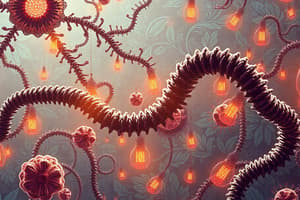Podcast
Questions and Answers
Phosphocreatine has a higher group-transfer potential than ATP.
Phosphocreatine has a higher group-transfer potential than ATP.
True (A)
Pyruvate can undergo tautomerization in phosphoenolpyruvate (PEP).
Pyruvate can undergo tautomerization in phosphoenolpyruvate (PEP).
False (B)
ATP provides energy solely through simple hydrolysis.
ATP provides energy solely through simple hydrolysis.
False (B)
Thioesters like acetyl-CoA have a large positive standard free energy of hydrolysis.
Thioesters like acetyl-CoA have a large positive standard free energy of hydrolysis.
NADH and NADPH serve as soluble electron carriers during metabolic reactions.
NADH and NADPH serve as soluble electron carriers during metabolic reactions.
High-energy phosphate compounds are produced in muscle during times of scarce ATP.
High-energy phosphate compounds are produced in muscle during times of scarce ATP.
The phosphoryl group transferred from ATP to glutamate results in the formation of glucose.
The phosphoryl group transferred from ATP to glutamate results in the formation of glucose.
1 calorie is equivalent to 4.184 joules.
1 calorie is equivalent to 4.184 joules.
Phosphocreatine and phosphoarginine are types of phosphoamides that have lower group-transfer potentials than ATP.
Phosphocreatine and phosphoarginine are types of phosphoamides that have lower group-transfer potentials than ATP.
The reaction for ATP hydrolysis is influenced by the concentrations of reactants and products as well as temperature.
The reaction for ATP hydrolysis is influenced by the concentrations of reactants and products as well as temperature.
In the presence of luciferase, luciferin is converted into oxyluciferin without the aid of oxygen.
In the presence of luciferase, luciferin is converted into oxyluciferin without the aid of oxygen.
Cells utilize ATP for various forms of biological work including mechanical work and active transport.
Cells utilize ATP for various forms of biological work including mechanical work and active transport.
Hydrolysis of phosphoenolpyruvate is catalyzed by adenylate kinase.
Hydrolysis of phosphoenolpyruvate is catalyzed by adenylate kinase.
Phosphagen molecules are produced in muscle during periods of low ATP availability.
Phosphagen molecules are produced in muscle during periods of low ATP availability.
ΔG1 and ΔG2 can be used to determine whether a reaction is thermodynamically favorable when coupled.
ΔG1 and ΔG2 can be used to determine whether a reaction is thermodynamically favorable when coupled.
The high-energy bonds in ATP are referred to as phosphoanhydride bonds due to their charge repulsion and resonance stabilization.
The high-energy bonds in ATP are referred to as phosphoanhydride bonds due to their charge repulsion and resonance stabilization.
Flashcards are hidden until you start studying
Study Notes
Phosphagens
- Phosphagens like phosphocreatine (PC) and phosphoarginine (PA) are high-energy molecules found in animal muscle.
- They have a higher group-transfer potential than ATP.
- They are produced in muscle during times of ample ATP.
- Phosphagens are used to replenish ATP when needed through the creatine kinase reaction.
Free Energy
- The actual free energy of ATP hydrolysis is very different from the standard free energy change.
- The standard free energy change (ΔGo’) is a theoretical value, while the actual free energy change (ΔG’) takes into account the concentration of reactants and products as well as temperature
- The actual free energy change can be calculated using the equation:
ΔG’ = ΔGo’ + RT ln ([C]c[D]d/[A]a[B]b)
Energy Coupling
- Energy derived from one reaction can be used to drive another reaction.
- Energy coupling involves combining a reaction with a negative free energy change (exergonic reaction) with a reaction with a positive free energy change (endergonic reaction).
Chemical Reactions in Cells
- Cells carry out thousands of enzyme-catalyzed reactions.
- Reactions occur at the active sites of enzymes.
- Examples of reactions in living cells include:
- Oxidation-reduction reactions (dehydrogenases)
- Group transfer reactions (kinases)
- Hydrolysis and dehydration reactions (hydrolases)
- Formation of double bonds (lyases)
- Isomerization (isomerases)
- Formation and breaking of C-C bonds (ligases)
Cellular Energy
- Cells require energy to perform essential biological work.
- Energy is needed for:
- Maintaining cellular structure (biosynthesis)
- Movement (mechanical work)
- Active transport
- Generating heat and light.
ATP as an Energy Carrier
- Energy from the oxidation of metabolic fuels is largely recovered in the form of ATP.
- ATP is a high-energy molecule due to:
- Charge repulsion between phosphate groups.
- Resonance stabilization of the phosphate groups.
- High entropy of the phosphate groups.
Hydrolysis of Phosphoenolpyruvate (PEP)
- PEP is a high-energy compound hydrolyzed by pyruvate kinase.
- The hydrolysis of PEP is followed by a spontaneous tautomerization of the product to pyruvate.
- Tautomerization is not possible in PEP, making the products of hydrolysis more stable.
Phosphoryl-Group Transfer Potential
- The ability of a compound to transfer its phosphoryl group is known as its phosphoryl-group-transfer potential.
- Energy-rich or high-energy compounds have group transfer potentials equal to or greater than that of ATP.
- Low-energy compounds have group transfer potentials less than that of ATP.
ATP Hydrolysis and Group Transfers
- ATP provides energy by group transfers, not by simple hydrolysis. This happens in multiple steps.
- A phosphoryl group is first transferred from ATP to a molecule like glutamate.
- The phosphoryl group is then displaced by another molecule, like NH3, and released as inorganic phosphate (Pi).
NADH and NADPH as Electron Carriers
- NADH and NADPH act as soluble electron carriers in reactions catalyzed by dehydrogenases.
- They are derived from vitamin niacin (source of nicotinamide).
- NADH absorbs at 340 nm.
Studying That Suits You
Use AI to generate personalized quizzes and flashcards to suit your learning preferences.




